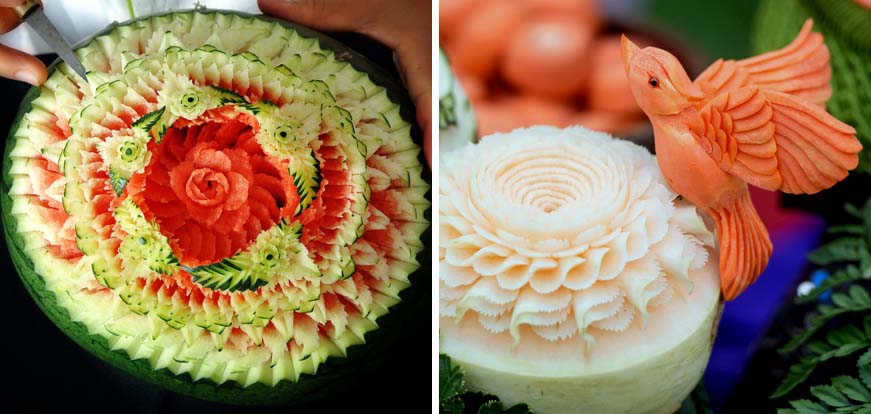
|
|
|
What's IotD? The interesting, amazing, or mind-boggling images of our days. |
|
IotD Stuff |
|
Permalink Latest Image |
|
|
|
Some folks who have noticed IotD
Neatorama |
|
Common image haunts
Astro Pic of the Day |
|
Advertising |
Feb 8th, 2020 :Thai Fruit carving
I posted the Jap chef carving fruit three weeks ago. He referred to it as Thai carving, although it goes back a long way in Japan
it apparently started in the Royal Thai kitchens
|
IN THE UNASSUMING BANGKOK CONDO that serves as Wan Hertz’s classroom, one wall is devoted to her certificates. Some are her credentials as a legitimately trained fruit carver; others are government endorsements attesting to her skills. And a handful are awards from global competitions, placing her in the top tier of fruit carvers in the world. “Anyone can be good at this, as long as you have perseverance,” says Hertz, who is helping Oklahoma couple Shevaun and Terrance Williams coax petals out of a stubborn carrot. All the same, she says, “the best carvers in the world are Thai.” |

|
In Thailand, the art of fruit carving, or kae sa lak polamai, was once showcased at every major event and banquet. Whereas Chinese carvers specialized in shaping human figures or animals and the Japanese preferred patterns, Thais excelled in floral motifs. Every main dish at a Thai restaurant with fine dining pretensions was accompanied by fruit or vegetables carved into flowers or leaves, and the artists themselves were featured in dining rooms, displaying their craft to the masses. Today, it is considered a dying art. At the same time, Thailand’s long history of fruit carving is being shunted to the background as international news stories trumpet the craft as a rising trend in the West. “There is no child who wants to do this,” says chef Supapit Opatvisan. A Thai culinary instructor at Le Cordon Bleu Dusit in Bangkok, he counts himself as having been one of those children, forced to learn fruit carving at school because the flower arrangement class was full. Learning to artfully carve fruits and vegetables is a traditional skill for Thai chefs, but there’s a catch. “You see the results slowly,” explains Opatvisan. “You discover you are good at it in six months, maybe a year.” When the king was especially pleased with a dish, he placed four baht (about $20 today) on the tray as a reward to the cook. Every household in the palace—headed by a different wife—vied for the honor of having the best table or excelling at a particular domestic art. It’s said to have originated in the Sukhothai era (1238-1438), when a concubine decorated a floating lantern with flower and bird shapes carved from fruit. |

|
Svasti—better known as the TV cooking personality Chef McDang—says that royal kitchen rules were myriad: no bones, pits or seeds; no extremes in flavor; only prime, seasonal ingredients. Diners were served Russian-style, with servers bringing trays to the table from which people could help themselves. Food was already cut into bite-sized pieces, so there were no knives in the table setting, even when Western food was on the menu. The monarch, seated at the middle of the table, had his own set of cutlery and dishes that no one else could ever use; his own food was served wrapped in muslin and closed with a wax seal. The seal could only be broken by his taster, who had to test his food for poison; as a result, the monarch’s food was always lukewarm at most. When he finished, everyone else had to be finished too. Naturally, every dish was garnished with beautifully carved fruits and vegetables. “There are 30 servants in the kitchen. They need something to do!” jokes Svasti. But “you don’t eat that, okay?” he says. “It’s a decoration. Don’t be an idiot.” Although Thai fruit carving is taught in schools and considered a cherished part of national culture, there are fewer and fewer places for carvers to display their craft. Hertz used to carve fruit for a host of hotel kitchens, from the Mandarin Oriental to the Marriott Riverside. Fruit carving at hotels has since gone by the wayside, replaced by a focus on spas. Today, she runs the Siam Carving Academy out of her home. |

| There is less of a focus on fruit and vegetable carving in fine Thai restaurants as well. “We used to do more of it,” Ruen Urai’s Vitayaku admits. “I see it as fuddy-duddy and old-fashioned. It is also a waste. You throw it away after two days.” |
or let a pig make bacon from it.
link
|
Your reply here?
The Cellar Image of the Day is just a section of a larger web community: a bunch of interesting folks talking about everything. Add your two cents to IotD by joining the Cellar. |